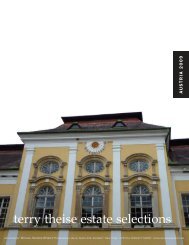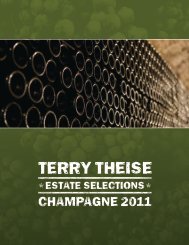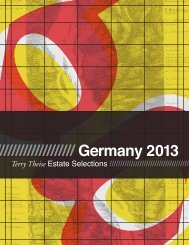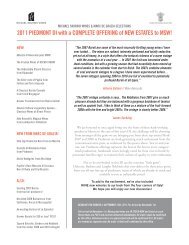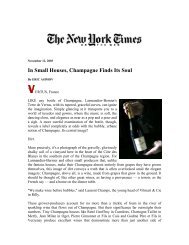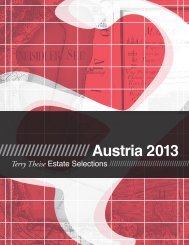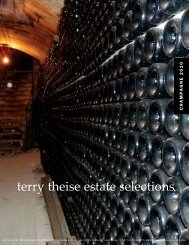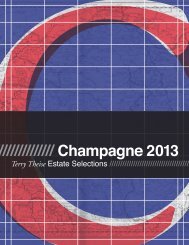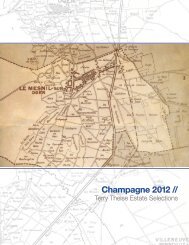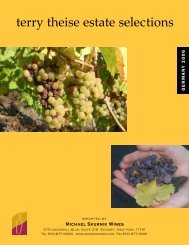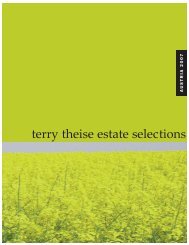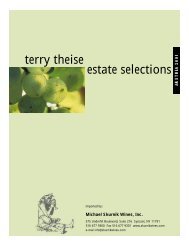View 2011 German Catalog - Michael Skurnik Wines
View 2011 German Catalog - Michael Skurnik Wines
View 2011 German Catalog - Michael Skurnik Wines
Create successful ePaper yourself
Turn your PDF publications into a flip-book with our unique Google optimized e-Paper software.
Nahe<br />
Kruger-Rumpf<br />
Kruger-Rumpf Nahe // Münster Sarmsheim<br />
vineyard area // 22 hectares<br />
annual production // 13,750 cases<br />
top sites & soil types // Münsterer Dautenpflänzer (slate with sandy loam);<br />
Münsterer Pittersberg (slate); Münsterer Rheinberg (weathered quartzite and sandy<br />
loam); Binger Scharlachberg Rheinhessen (Rotliegend and porphyry)<br />
grape varieties // Riesling, Pinot Blanc, Pinot Gris, Pinot Noir, Scheurebe<br />
This was the first year I went and Stefan wasn’t there. We couldn’t get our schedules to<br />
mesh; he and Cornelia were in Normandy on a long-planned vacation, and the week they<br />
were gone was the only week I was in the vicinity. But it was OK, because Georg got to be<br />
Le Patron and take us through the wines.<br />
I confess I was curious. Rumpf’s wines have been<br />
best in years when the vintage texture was already graceful.<br />
What would prevail, in the 2010 battle between density<br />
and angularity? And many of you have noticed an uptick<br />
in quality here, and it’s always fun when those go on. In<br />
general, I think ’10 is admirably consistent here, except for<br />
the dry wines, for which the vintage was often unsuited.<br />
One might miss the highest notes of ’09 and ’08, but one is<br />
reassured by the many generously ripe, lusty fellows in ’10.<br />
Maybe it’s because his children are growing up and<br />
helping out (kids have a way of giving their dads a kick<br />
in the pants, don’t they . . .), and maybe it’s just simple<br />
ambitiousness, but there’s no doubt Stefan Rumpf has<br />
taken a significant step forward in each of the last three<br />
vintages. I’m just guessing here, but I intuit a subtle kind<br />
of competition between Stefan and son Georg. Dad has<br />
an audience now, and he wants to show off a little, to earn<br />
the boy’s respect. I saw them spur each other on while we<br />
were tasting, and felt the frisky new energy.<br />
It’s also worth pointing out the wines are<br />
improving in matters of texture, of polish and gloss and<br />
a finer mouthfeel. Fruit was always there, but the tones<br />
have improved. In fact everything is improved yet the<br />
prices have stayed the same. Hmmm. . .<br />
Kruger-Rumpf at a glance // Up-and-comer the past few years, making more glamorous wines than ever<br />
before. Deft, appley and minerally wines from the greatest sites of the lower Nahe. Priced quite reasonably for<br />
blue-chip quality.<br />
how the wines taste // They’re as sturdy as before but there’s more flesh on the bones. There’s more<br />
mineral density, more complexity of texture, and they are invariably site-specific: The PITTERSBERGS are still<br />
nutty and slatey, the DAUTENPFLÄNZERS are still complex and multi-faceted, with all the intricacies of real<br />
Grand Cru style, but the fabric is finer now. You know the hoary old truism about Nahe wines being a cross<br />
between Mosel and Rheingau? When you taste these you’ll see the truth behind the cliché.<br />
56<br />
I do think a small tribute is in order for his<br />
geniality. Many producers, especially young studs<br />
in their twenties, can be quite the divas. “I make the<br />
wines I like and he takes them or leaves them” is a typical<br />
sentiment. And it’s reasonable enough on its face; it only<br />
locks a door whereby collegial interaction might benefit<br />
grower and buyer alike. But hey, I understand, having<br />
been an insufferable twit in my twenties, and I didn’t have<br />
to deal with boffo reviews before I was old enough to<br />
handle them gracefully. All of which is to say that Stefan<br />
Rumpf’s collegiality is becoming rare, which makes its<br />
underlying gesture of respect and friendliness even more<br />
precious. I am also delighted to see their willingness to<br />
still use dosage as a means of fine-tuning, which is part of<br />
a larger willingness to eschew dogma and surf all possible<br />
options according to the needs of the wine. I’d like to hire<br />
a plane and fly a banner over the Mainzer Weinbörse—<br />
DOSAGE IS NOT EVIL, BUT DOGMA IS. A good dosage<br />
from top-site Riesling, used to finetune just before bottling,<br />
nearly always works better— which is to say tastes better—<br />
than throwing in a BA or other sweet wine, which often<br />
muddies the waters. This is out of tune with the Zeitgeist but<br />
the zeitgeist is full of shit. Buncha smug young twits with their<br />
holier-than-thou posturing and their purity tests. . .



